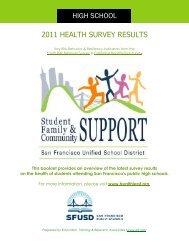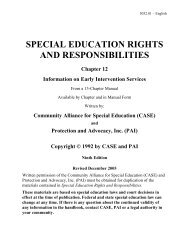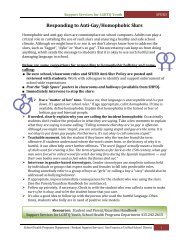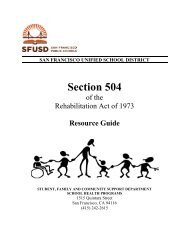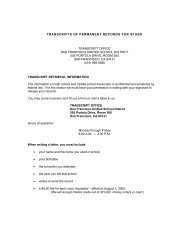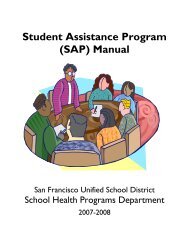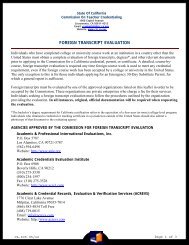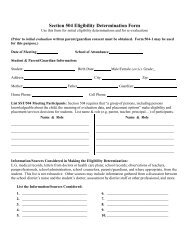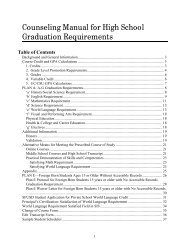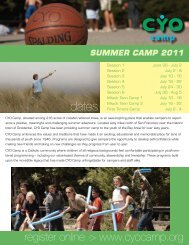PERSIMMONS - Harvest of the Month
PERSIMMONS - Harvest of the Month
PERSIMMONS - Harvest of the Month
You also want an ePaper? Increase the reach of your titles
YUMPU automatically turns print PDFs into web optimized ePapers that Google loves.
S tudent Sleuths1 Some persimmon varietiescontain tannins, whichcause astringency. Whatare tannins? What areo<strong>the</strong>r sources <strong>of</strong> tannins?2 Persimmons are high inantioxidants. What areantioxidants and what do<strong>the</strong>y do for <strong>the</strong> body?3 What is beta-carotene? Describe how beta-carotene isconverted to vitamin A in <strong>the</strong> body.4 Create a presentation on several fruits and vegetablesfrom different parts <strong>of</strong> <strong>the</strong> plant we eat (roots, seeds,leaves, fruits, etc.). List <strong>the</strong> key nutrients found in eachitem and <strong>the</strong> health benefits <strong>of</strong> <strong>the</strong>se nutrients.5 What are <strong>the</strong> top three persimmon-producing countiesin California? Locate on a map. When do <strong>the</strong>seregions harvest persimmons? What similarities are<strong>the</strong>re between <strong>the</strong>se counties (e.g., climate, location,geography)?For information, visit:www.crfg.org/pubs/ff/persimmon.htmlwww.nal.usda.gov/fnic/foodcomp/search/A Slice <strong>of</strong> Persimmon Historyn The D. kaki species originated in China and made itsway to Japan more than a thousand years ago.*n Commodore Perry brought seeds back to <strong>the</strong> UnitedStates from Japan after his 1852-54 expedition. Theseeds were first planted in <strong>the</strong> area around Washington,D.C., but were killed by an early frost.n In 1870, grafted trees were successfully introduced intoGeorgia and California by early USDA plant explorers.n At least 500 different D. kaki varieties were broughtto California during a major planting spree from 1870to 1920. In 1877 alone, more than 5,000 plants in 19varieties were imported from Japan.n Today, <strong>the</strong> two major Japanese varieties grown inCalifornia are <strong>the</strong> Hachiya and <strong>the</strong> Fuyu.*Persimmons <strong>of</strong> <strong>the</strong> species D. virginiana (American persimmon) arenative to North America, mostly on <strong>the</strong> East Coast. While it was a foodstaple <strong>of</strong> early Native Americans, <strong>the</strong> species today accounts for less than1 percent <strong>of</strong> <strong>the</strong> country’s total crop production.For more information, reference:Chez Panisse Fruit, Alice Waters, 2002.http://food.oregonstate.edu/faq/uffva/persimmon2.htmlSchool Garden: Cover CropsLate fall is an ideal time to clean up <strong>the</strong> garden fromsummer and prepare it for winter using a cover crop.Cover crops provide soil cover and prevent soil erosion.A legume is a great choice for a winter cover crop for <strong>the</strong>added benefit <strong>of</strong> nitrogen. Easy to grow nitrogen rich plantsare: red clover, alfalfa, fava beans, or peas. Humans needprotein to grow properly. Nitrogen is a component <strong>of</strong> <strong>the</strong>protein foods that we eat. Animal and plant foods provideus with protein in our diet.Activity:Have students identify protein foods that come from animaland plant sources. This can be done with pictures <strong>of</strong>different types <strong>of</strong> food. Discuss how we can eat plant foodshigh in protein to replace animal protein in a meal.For more ideas, reference:The Growing Classroom, Roberta Jaffe and Gary Appel, Life Lab ScienceProgram, 1990, pp. 93-95.Home Grown Factsn In 2004, California produced 99 percent<strong>of</strong> <strong>the</strong> D. kaki crop in <strong>the</strong> United States.n Tulare and Fresno counties produce53 percent <strong>of</strong> <strong>the</strong> state’s total production.n O<strong>the</strong>r major persimmon-producing regionsinclude Orange, Riverside, and San Diegocounties. A small percentage is grown in Sutter andPlacer counties.n Persimmons reached <strong>the</strong>ir peak in popularity during<strong>the</strong> first half <strong>of</strong> <strong>the</strong> 20th century. The Hachiya was <strong>the</strong>preferred variety, but production declined and has sincebeen surpassed by <strong>the</strong> Fuyu.For more information, visit:www.cdfa.ca.govwww.crfg.org/pubs/ff/persimmon.htmlJust <strong>the</strong> Factsn In Asia, persimmons have been cultivated for thousands<strong>of</strong> years and rank next to citrus fruit in importance,culturally and economically.n The persimmon is Japan’s national fruit.n The art <strong>of</strong> hoshigaki — hand-dried persimmons — isan integral part <strong>of</strong> traditional Japanese New Year’scelebrations.n The Fuyu was developed by breeding out <strong>the</strong> tannic acidfrom <strong>the</strong> Hachiya, making it more appealing to taste andeasier to eat whole and raw.n Persimmon trees are also cultivated for timber(used in golf clubs, textile weaving, and furniture),wildlife (flowers produce nectar for honeybees), andbeautification.Source:Chez Panisse Fruit, Alice Waters, 2002.www.mfc.state.ms.us/seedlings/
S tudent AdvocatesAfter <strong>the</strong> persimmon was introduced in America in <strong>the</strong> late1800s, it became one <strong>of</strong> <strong>the</strong> country’s most popular fruits,particularly in California. Although California continues tolead <strong>the</strong> nation in persimmon production, its popularityhas declined considerably. Using what <strong>the</strong>y have learnedin class, students can “re-introduce” <strong>the</strong> persimmon to <strong>the</strong>community.n Write an article that describes <strong>the</strong> two main varieties and<strong>the</strong> nutritional benefits. Include examples <strong>of</strong> how <strong>the</strong>ycan be used in meals and recipes. Submit articles tolocal print outlets.n Design posters or brochures to promote <strong>the</strong> nutritionalbenefits and uses <strong>of</strong> persimmons. Include healthyholiday recipes. Display on campus or at grocery stores,persimmon stands, or farmers’ markets.Physical Activity CornerMovement increases breathing and heart rate so that moreblood flows to <strong>the</strong> brain. Integrating physical activity into<strong>the</strong> classroom can help optimize student performance.Objective:Kines<strong>the</strong>tic movement, nutrition educationActivity:n Students jump up and down (or hop on one leg)*n Call out one <strong>of</strong> <strong>the</strong> fruit/vegetable color groups (red,green, yellow/orange, etc.)n One at a time, each student calls out a fruit or vegetablewithin named color groupn Continue for all color groups*Variations may involve identifying different movements to represent fruitsand vegetables or <strong>the</strong> different color groups. For example, jumping mayrepresent red fruits while running in place may represent blue/purplevegetables.For more ideas, visit:www.take10.netCafeteria ConnectionsThe sweet and spicy Fuyu has apricot and cinnamonflavors that are appealing to children. It is easy to prepareand does not brown quickly. Introduce students to thisunique fruit by incorporating it into <strong>the</strong> school menu. Shareserving ideas with school nutrition staff.n Use firm Fuyus as a “cracker” and pair with o<strong>the</strong>r fruitsor lowfat cheese.n Pair Fuyu with a crisp vegetable and a dip.n Offer sliced or shredded persimmons in <strong>the</strong> salad bar.O<strong>the</strong>r ideas for incorporating persimmons.n Ask students (grades K-5) to develop a snack recipe.n Ask students (grades 6-8) to develop a lunch recipe.n Ga<strong>the</strong>r healthy holiday recipes that contain persimmonsto share with students and families.For more ideas, visit:www.fns.usda.gov/tn/Literature LinksAsk librarian to help students with a research project.Divide students into groups to research <strong>the</strong> ancientJapanese art <strong>of</strong> hoshigaki. Have students select a topic <strong>of</strong>interest and present findings to class in <strong>the</strong> library. Topicsmay include:n Demonstration <strong>of</strong> method used to hand-dry <strong>the</strong> fruitn How <strong>the</strong> practice/art evolved and how it is different todayn Historical significance in Asian culturen Global locations <strong>of</strong> where it is practiced todayFor background information and book lists, visit:www.cfaitc.org/trg/pdf/trg2009.pdfwww.cfaitc.org/Bookshelf/Bookshelf.phpwww.sarep.ucdavis.edu/cdpp/foodsystemswww.slowfoodusa.org/ark/japanese_persimmon.htmlAdventurous ActivitiesScience Exploration:Cut persimmons will brown when exposed to air. Askstudents to first research <strong>the</strong> concept <strong>of</strong> enzymaticbrowning or oxidation. Have students hypo<strong>the</strong>size whatcan be done to prevent this reaction from occurring. Thentest students’ hypo<strong>the</strong>ses in an experiment using both Fuyuand Hachiya persimmons. Students compile information ongraphs and present to <strong>the</strong>ir peers.For more activities, visit:www.harvest<strong>of</strong><strong>the</strong>month.comThis material was produced by <strong>the</strong> California Department <strong>of</strong> Public Health’s Network for a Healthy California with funding from <strong>the</strong> USDASupplemental Nutrition Assistance Program (formerly <strong>the</strong> Food Stamp Program). These institutions are equal opportunity providers andemployers. In California, food stamps provide assistance to low-income households and can help buy nutritious foods for better health.For food stamp information, call 877-847-3663. For important nutrition information, visit www.cachampionsforchange.net.© California Department <strong>of</strong> Public Health 2010.



